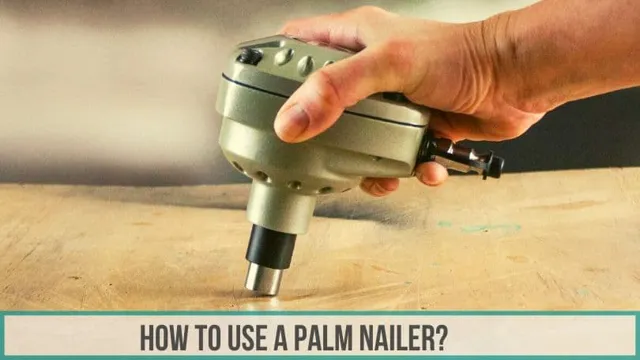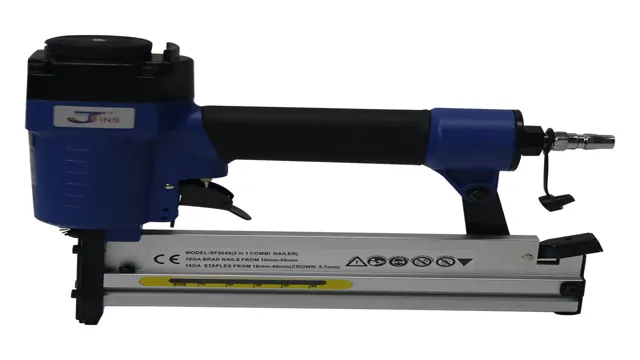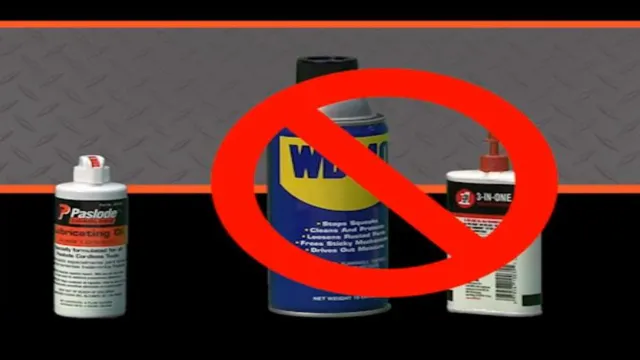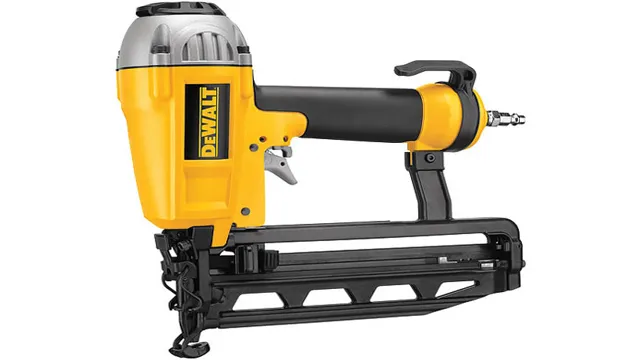What Type of Air Nailer for Trim: A Comprehensive Guide to Choosing the Best Option
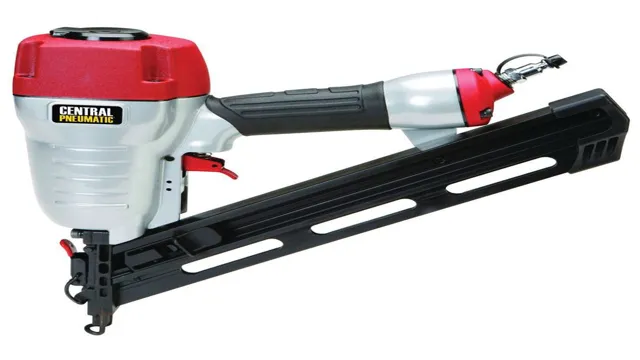
Are you struggling to decide on the perfect air nailer for your trim project? With so many options available in the market, finding the right one can be overwhelming. But fear not! In this blog, we will guide you through the process of choosing the best air nailer for your trim. Selecting the right air nailer for trim work is crucial to achieving a professional and polished finish.
It’s essential to consider factors such as the size of the trim, the type of nails required, and the air pressure needed to carry out the task efficiently. We understand that the technical details can be intimidating, so we’ve simplified the process by breaking down the essential features to look for in an air nailer. We’ll discuss the different types of air nailers and their pros and cons, as well as the necessary precautions to take during their usage.
Whether you’re a DIY enthusiast or a professional carpenter, this blog has got you covered. We aim to provide you with all the information you need to choose the right air nailer for your trim without breaking the bank. So, let’s dive in and revolutionize your trim work with the perfect air nailer!
Understanding Trim Nailers
If you’re looking to do some trim work, then you’ll definitely want to get your hands on a trim nailer. This type of air nailer is specifically designed for trim work and is perfect for installing baseboards, crown molding, and door frames. Trim nailers are also great for smaller projects, where a larger nailer would be overkill.
The best thing about these nailers is that they’re easy to use and produce a professional-looking finish every time. So if you’re wondering what type of air nailer you need for trim work, then a trim nailer should definitely be at the top of your list. Plus, they’re affordable and can last for years with proper maintenance!
Types of Trim Nailers
Trim nailers are an essential tool for any DIY enthusiast or professional woodworker. They come in two main types: finish nailers and brad nailers. Finish nailers can handle thicker and longer nails, making them ideal for larger trim pieces.
Brad nailers, on the other hand, use thinner and shorter nails and are best suited for smaller trim pieces or delicate materials. Both types of trim nailers use compressed air or electricity to drive nails, offering a faster and more convenient method of attaching trim pieces than traditional hammers and nails. Understanding the capabilities and uses of each type of trim nailer is crucial to ensure you select the right tool for your specific project needs.
Whether you’re looking to spruce up your home’s interior or create intricate woodwork for a client, trim nailers can make the job easier and faster.
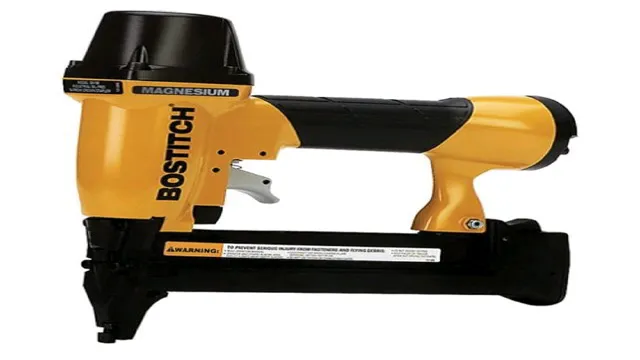
Pneumatic vs Cordless Nailers
If you’re in the market for a trim nailer and trying to decide between a pneumatic or cordless option, there are a few key differences to consider. Pneumatic nailers require an air compressor to operate, while cordless nailers rely on battery power. Pneumatic options tend to be more powerful and consistent in their firing, but require a bit more setup time and are less portable.
Cordless options, on the other hand, offer greater convenience and portability but may lack the power and consistency of their pneumatic counterparts. Ultimately, the decision between pneumatic and cordless comes down to your specific needs and preferences. Are you looking for a high-powered option for heavy-duty projects, or would the convenience of a cordless option be more beneficial for your workflow? By considering these factors, you can choose the trim nailer that’s right for you.
Considerations for Trim Nailers
When it comes to choosing the right type of air nailer for trim work, there are a few things to consider. First and foremost, you’ll want to make sure you’re using a finish nailer, which is specifically designed for working with trim materials. These nailers use smaller, thinner gauge nails that are less likely to split wood or damage the surface of your trim.
Additionally, you’ll want to think about the size and shape of the nails you’ll be using, as well as the capacity of the nailer’s magazine. A larger magazine capacity can be helpful for larger projects or longer periods of use without needing to reload. Finally, consider the power source for your nailer – pneumatic nailers require a compressor, while cordless models use batteries.
Regardless of which type you choose, make sure it has enough power and versatility to handle all of your trim nailing needs.
Gauge of Nails Needed
When it comes to choosing the gauge of nails for your trim nailer, there are a few things to consider. First, you need to make sure that the nail is the right length for the trim you are installing. Second, the gauge of the nail needs to be strong enough to hold the trim in place.
The most common gauges for trim nailers are 15 and 16, with 16 being the thinner option. However, while 16 gauge nails may be easier to work with and cheaper, they may not provide enough support for thicker or heavier trim pieces. Conversely, 15 gauge nails are thicker and stronger, making them ideal for heavier trims, but they can be harder to work with and more expensive.
Ultimately, the choice of gauge will depend on the type of trim you are working with and the level of support it requires. So, before you start your trim project, take the time to consider the gauge of nails needed to ensure the best results.
Nailer Size and Weight
When it comes to choosing a trim nailer, you want to make sure you have the right size and weight for the job. The size of the nailer determines the size of the nail it can handle, and you want to make sure you’re using the right size nail for the trim you’re working on. A larger nail may hold better, but it can also split the wood, while a smaller nail may not hold as well.
As for weight, you want to choose a nailer that’s comfortable to hold and maneuver, especially if you’ll be using it for extended periods of time. A heavier nailer may be more durable, but it can also be more tiring to use. Overall, it’s important to find the right balance between size and weight to ensure you have a nailer that’s both effective and comfortable to use.
So, whether you’re a professional carpenter or a DIY enthusiast, make sure to consider these factors when selecting your next trim nailer.
Magazine Capacity
When it comes to trim nailers, magazine capacity is an important consideration to keep in mind. This refers to the number of nails that can be held by the nailer’s magazine at one time. The magazine capacity can vary from one model to another, and can impact how often you need to reload the nailer.
If you’re working on a larger project that requires a lot of nailing, a larger magazine capacity may be ideal. Conversely, if you need to carry the nailer around with you often, a smaller magazine capacity may be more convenient. The keyword here is “magazine capacity,” and it plays a key role in determining the optimal trim nailer for your specific needs.
So, before purchasing any nailer, make sure to check its magazine capacity to ensure it aligns with your project requirements.
Recommendations for Trim Nailers
When it comes to nailing trim, a brad nailer or finish nailer is typically the go-to option. A brad nailer is ideal for thinner trim pieces because it uses smaller gauge nails that won’t split the wood. Finish nailers, on the other hand, are great for larger trim pieces as they use slightly larger gauge nails that will provide a stronger hold.
Both options usually require an air compressor, which can be a bit of an investment. However, if you plan on doing a lot of trim work, it’s worth the cost. Overall, determining which type of air nailer for trim will depend on the size of the trim pieces you will be working with.
Top 3 Pneumatic Trim Nailers
Are you in search of the perfect pneumatic trim nailer for your DIY projects or professional jobs? Look no further, as we have compiled a list of the top 3 pneumatic trim nailers on the market. Firstly, the Bostitch Smart Point 18 Gauge Brad Nailer is a popular choice for its precision and durability. The tool features a narrow nose design that allows for easy access to tight spaces, making it perfect for finishing work.
Secondly, the DEWALT DWFP12231 Pneumatic 18-Gauge 2-Inch Brad Nailer kit stands out for its ease of use and reliability. The nailer comes equipped with a rear exhaust to keep debris away from the user, and its oil-free operation eliminates the need for maintenance. Finally, the Hitachi NT50AE2 18-Gauge 5/8-Inch to 2-Inch Brad Nailer is a powerful tool that is perfect for both professional and DIY use.
The nailer features a selective actuation switch that allows for easy transitions between sequential and contact nailing. Each of these trim nailers has its unique features and capabilities. Choose the one that best fits your needs to complete your projects efficiently and effectively.
Top 3 Cordless Trim Nailers
If you’re looking for a trim nailer that offers the flexibility of cordless operation, you’ll want to check out these top three picks. First up is the DeWalt DCN680, which features a brushless motor that offers a longer lifespan and improved efficiency. It also offers a tool-free depth adjustment for precision, and the lightweight design makes it easy to maneuver.
Another great option is the Milwaukee M18 Fuel, which offers exceptional power and can fire up to 700 nails on a single charge. It also offers a belt hook for added convenience on the job site. Finally, the Ryobi P325 is a great budget-friendly choice, offering a longer run time compared to similar models on the market.
Its compact design also allows for easy access in tight spaces. Whatever your needs, these cordless trim nailers are sure to help you get the job done right.
Conclusion and Final Thoughts
After careful consideration and analysis, it’s clear that the best type of air nailer for trim work depends on the specific needs and preferences of the user. Whether it’s a finish nailer for delicate work or a brad nailer for speedy installation, each option has its own strengths and weaknesses. Ultimately, it’s up to the user to decide which tool works best for their trim needs.
Just be sure to use caution and precision when using any type of power tool – and leave the DIY dentistry to the professionals.”
FAQs
What is an air nailer for trim?
An air nailer for trim is a tool which uses compressed air to drive nails into decorative trims, moldings and baseboards.
What are the different types of air nailer for trim?
The different types of air nailer for trim include the brad nailers, finish nailers and pin nailers.
What is a brad nailer?
A brad nailer is a type of air nailer for trim that uses small gauge nails (18-gauge) that leave tiny holes which are easily concealable with paint.
What is a finish nailer?
A finish nailer is a type of air nailer for trim that uses larger gauge nails (15- or 16-gauge) for stronger hold and can be used for a wider range of applications.
What is a pin nailer?
A pin nailer is a type of air nailer for trim that uses the smallest gauge nails (23-gauge) and leaves almost no visible marks, making it perfect for delicate trims.
What type of air nailer for trim should I use for baseboards?
A finish nailer with a 15- or 16-gauge nail is recommended for installing baseboards.
Can I use an air nailer for trim for other woodworking applications?
Yes, an air nailer for trim can also be used for other woodworking applications such as building furniture, cabinets, and framing.

